How Neuroplasticity Supports Emotional Growth: Rewiring the Brain for Resilience
Introduction
For centuries, people believed the adult brain was fixed — that once you reached a certain age, your neural wiring was set in stone. But modern neuroscience has shattered that myth. The brain isn’t static; it’s alive, dynamic, and adaptable. It can change its structure, function, and chemistry in response to experience, practice, and emotion.
This remarkable ability is called neuroplasticity, and it’s the foundation for both learning and healing. 🌿
When it comes to emotional growth — learning to manage stress, release trauma, and build resilience — neuroplasticity is the invisible force working behind the scenes. It explains how you can move from anxiety to calm, from reactivity to control, and from survival to self-mastery.
Let’s explore how the brain rewires itself, how emotions shape those pathways, and how you can consciously engage neuroplasticity to grow emotionally stronger every day. 💫
Looking for supplements for Emotional Growth? Click here.
🧬 What Is Neuroplasticity?
Neuroplasticity is the brain’s ability to reorganize itself by forming new neural connections.
Every thought, emotion, or behavior activates certain neurons — and when those neurons fire together repeatedly, the brain strengthens their connection.
“Neurons that fire together, wire together.” — Donald Hebb
This means your emotional reactions, habits, and beliefs are not permanent; they’re patterns. And patterns can change.
Neuroplasticity happens on two levels:
Structural plasticity: physical changes in the brain’s anatomy, such as new synapses forming or old ones pruning.
Functional plasticity: the brain’s ability to shift activity from one area to another when adapting or recovering from damage.
So when you learn a new coping strategy, practice gratitude, or meditate — you’re literally reshaping your brain. 🧠✨
🌊 The Emotional Brain: Where Feelings and Circuits Meet

Emotions aren’t just “in your head” — they’re deeply physiological, involving networks across the brain:
Amygdala: the alarm system that detects threats.
Hippocampus: processes emotional memories.
Prefrontal cortex: regulates emotion and decision-making.
Anterior cingulate cortex: manages empathy and conflict resolution.
When we experience emotional pain or trauma, the amygdala becomes overactive while the prefrontal cortex (our rational control center) weakens its influence.
But with neuroplasticity, that balance can be restored. Practices that build emotional intelligence — mindfulness, therapy, or compassionate self-reflection — strengthen prefrontal control and calm the amygdala, creating a new emotional map.
This is how emotional growth emerges at the neural level: through consistent re-patterning of thought and feeling.
⚡ Emotional Triggers and Brain Wiring
Think about a time you felt sudden anger or fear — faster than you could think. That reaction wasn’t your conscious mind; it was a neural shortcut built from repetition.
For example:
A child criticized often may develop automatic shame responses.
A person betrayed in love may associate vulnerability with danger.
These are examples of maladaptive neural pathways — protective at one time, but limiting later.
Neuroplasticity allows us to update those emotional circuits. Through conscious awareness, therapy, or new experiences, the brain learns that the old danger is gone.
It’s not “positive thinking” — it’s neural retraining.
🪶 The Science of Rewiring Emotions
Here’s how emotional neuroplasticity works step by step:
Activation
An emotional pattern (like anxiety or fear) is triggered. The old neural pathway lights up.
Awareness
You bring conscious attention to your reaction — observing the feeling instead of automatically reacting.
Interruption
You apply a new response: deep breathing, self-soothing, reframing, or pausing.
Repetition
Each time you choose the new response, the new pathway strengthens while the old one weakens.
Integration
Eventually, the brain favors the new pathway automatically. The emotional reaction transforms.
This process is called synaptic pruning — the brain trims unused connections and fortifies useful ones. 🌱
🌞 Emotional Growth Through Neuroplastic Habits
The good news: You can rewire your emotional brain through consistent daily actions. Let’s explore how.
🧘 Mindfulness and Meditation
Mindfulness trains attention and reduces amygdala hyperactivity — literally shrinking its size over time. Meanwhile, it strengthens the prefrontal cortex and insula (the center for self-awareness).
Regular meditation helps you observe emotions without being controlled by them, turning reactivity into calm response.
🪷 Think of mindfulness as daily emotional weightlifting — every breath builds strength.
🧠 Cognitive Reframing (Therapy and Self-Talk)
Therapies like CBT (Cognitive Behavioral Therapy) leverage neuroplasticity by helping you identify distorted thought patterns and replace them with healthier interpretations.
When you challenge negative self-talk — like “I always fail” — and replace it with “I’m learning and improving,” your brain forms new neural pathways of self-compassion.
💡 Over time, new emotional beliefs become the default.
Looking for online therapy ? Click Here.
🌬️ Breathwork and Body Awareness
Deep, slow breathing signals the vagus nerve — the body’s relaxation switch — to calm the nervous system.
This teaches the brain that intense emotions can be met with safety, not panic. Over time, breath-centered awareness rewires the emotional response to stress.
💨 Every deep breath is a neural message of peace.
Want to try Breathwork? Click Here.
💞 Gratitude and Positive Emotion Training
Practicing gratitude or appreciation activates the brain’s reward circuitry (dopamine and serotonin pathways).
Regular gratitude practice enhances neuroplasticity in the ventromedial prefrontal cortex, helping you naturally focus on possibility and connection instead of fear.
🌸 You rewire your perception of life itself.
Looking for online therapy ? Click Here.
🌳 Movement and Exercise
Exercise increases Brain-Derived Neurotrophic Factor (BDNF) — a protein that supports neuron growth and repair.
Tai Chi, yoga, or dance-based therapies integrate motion and mindfulness, building emotional regulation through body-brain synchronization.
💪 Move your body, and your emotions move with it.
🎶 Music, Art, and Creativity
Creative expression activates neuroplasticity by engaging both hemispheres of the brain.
Art and music therapy can help rewire trauma circuits, enabling the safe release of repressed emotion while forming new positive associations.
🎨 When words can’t heal, rhythm and color can.
💤 Sleep and Recovery
Neural changes consolidate during sleep. REM sleep, in particular, processes emotional memories and reduces their charge.
Sleep is your brain’s natural “reset” — the time when emotional circuits integrate new learning.
🌙 Healing requires rest as much as effort.
🧩 Trauma and the Plastic Brain
For those recovering from trauma, neuroplasticity is a profound gift.
Trauma locks the nervous system into survival mode, making the amygdala hypersensitive and the prefrontal cortex less active. But targeted therapies can reverse this wiring.
💫 Methods That Use Neuroplasticity for Trauma Healing
EMDR (Eye Movement Desensitization and Reprocessing): helps the brain reprocess traumatic memories.
Somatic Experiencing: reconnects awareness between body and mind.
Neurofeedback: retrains brainwave patterns to promote calm focus.
Cold exposure and breathwork: strengthen vagal tone and reduce fear reactivity.
Each method gently rewires the brain to interpret safety instead of threat — transforming survival into serenity.
Healing trauma isn’t erasing the past — it’s teaching your brain that the danger is over. 🕊️
🧘 The Role of the Vagus Nerve
The vagus nerve is like an emotional bridge between the body and brain. It sends 80% of its signals upward — from body to mind.
Practices that stimulate vagal tone — such as humming, cold therapy, chanting, or deep breathing — promote neuroplasticity in emotional regulation centers.
When vagal tone improves, your brain rewires to experience calm as the new normal. 🌿
🪷 Emotional Intelligence and Neuroplasticity
Emotional intelligence (EQ) — the ability to understand, regulate, and express emotions — grows through neuroplastic adaptation.
Each time you practice empathy, delay reactivity, or approach conflict mindfully, you strengthen neural circuits in the anterior cingulate cortex and prefrontal cortex.
Over time, emotional intelligence becomes embodied — it’s not forced; it’s wired in.
💬 Neuroplasticity makes emotional growth measurable — and achievable.
🌈 The Power of Intention and Attention
The brain changes according to what you focus on most.
Neuroscientist Dr. Rick Hanson calls this principle “experience-dependent neuroplasticity.” When you repeatedly focus on calm, gratitude, or connection, your brain rewires itself to favor those states.
👉 Focus is your superpower.
Every time you bring attention to peace instead of fear, or love instead of resentment, you sculpt new emotional pathways.
🧠 What you feed your attention to becomes your emotional landscape.
🔄 Breaking Old Emotional Loops
Many emotional struggles — like anxiety, guilt, or self-doubt — are feedback loops reinforced by habit.
Neuroplasticity gives you the power to break them.
Identify the trigger. (e.g., criticism, rejection)
Observe your reaction. (notice the sensations, not the story)
Introduce a pause. (breathe, relax, choose)
Replace with new behavior. (kindness, curiosity, reframing)
Each repetition weakens the old pattern and strengthens a new one.
🧩 You’re not your reaction; you’re your reprogramming.
💞 Compassion: The Ultimate Neural Reset

Compassion isn’t just a moral virtue — it’s a biological one.
Acts of kindness and self-compassion activate the insula and anterior cingulate, increasing connectivity in brain areas linked to emotional regulation and empathy.
Practicing compassion — for yourself and others — reshapes your neural architecture for peace, connection, and belonging.
💗 Kindness rewires the brain toward safety.
🔬 How Neuroplasticity Changes With Age
Contrary to old beliefs, neuroplasticity doesn’t stop after childhood — it continues throughout life. However, it becomes experience-dependent, meaning change requires consistent engagement.
Think of your 40s, 50s, or 60s as prime time for emotional neuroplasticity:
You have more perspective.
You can choose deliberate practices.
Your brain still forms new connections through learning and mindfulness.
🧠 Emotional maturity + neuroplastic flexibility = lifelong growth.
🌺 Supplements and Nutrients That Support Neuroplasticity
Certain nutrients help fuel the brain’s ability to adapt and repair emotional circuits:
| Nutrient / Supplement | Function |
|---|---|
| Omega-3 Fatty Acids | Supports synapse formation and brain fluidity |
| Magnesium Threonate | Enhances learning and calm focus |
| B Vitamins (B6, B12, Folate) | Neurotransmitter synthesis |
| Lion’s Mane Mushroom | Stimulates nerve growth factor (NGF) |
| N-Acetyl-Cysteine (NAC) | Reduces oxidative stress, supports mood regulation |
| Rhodiola Rosea | Modulates stress response and neuroendocrine balance |
Combine these with consistent mental and emotional practices for a holistic approach to neuroplastic healing. 🌿
Looking for supplements for Emotional Growth? Click here.
🌙 Integration: Turning Insight Into Wiring
Awareness is the first step, but consistency is what rewires the brain.
For neuroplasticity to stick, practice needs three key ingredients:
Repetition: Frequent engagement strengthens new pathways.
Emotion: Emotional significance accelerates rewiring.
Focus: Mindful attention directs neural energy.
In short: what you practice, you become.
Even five minutes of daily mindfulness or gratitude journaling can produce measurable changes in brain connectivity within weeks.
“Small moments, many times.” — Dr. Daniel Siegel
🔁 The Feedback Loop of Growth
Here’s how emotional growth builds upon itself:
Practice awareness → new neural pathways form.
New pathways → improved regulation and insight.
Improved regulation → more positive experiences.
Positive experiences → further neural reinforcement.
This self-reinforcing loop turns emotional work into neural architecture.
🌻 Everyday Ways to Strengthen Emotional Neuroplasticity
🧘 Practice 10 minutes of daily meditation.
✍️ Journal emotions with curiosity, not judgment.
🌿 Take mindful walks observing nature.
🎶 Listen to uplifting music that stirs emotion.
🤝 Engage in meaningful connection and conversation.
💤 Prioritize deep, consistent sleep.
💪 Learn new skills that challenge both body and mind (like Tai Chi, dancing, or learning an instrument).
Every one of these small habits strengthens emotional pathways — bit by bit, moment by moment.
💬 Real-World Transformation Example
Sofia, a 38-year-old teacher, had struggled with anxiety for years. Through therapy, mindfulness, and breathing exercises, she noticed her body reacting differently to stress.
After months of consistent practice, she described feeling “wired differently” — calmer under pressure, more patient, and more compassionate with herself.
That’s neuroplasticity in action — her emotional resilience wasn’t imagined; it was physically built in her brain.
🧘 From Reaction to Response
When you understand neuroplasticity, every emotional challenge becomes an opportunity.
A stressful moment isn’t just something to endure — it’s a chance to train new pathways.
A setback isn’t failure — it’s feedback.
Every conscious breath, kind word, or self-aware decision becomes brain sculpting.
Over time, your emotional responses evolve from impulsive to intentional, from fragile to flexible. 🌿
🌞 Final Thoughts: Rewiring for Resilience
Your brain is not a cage — it’s clay.
It molds itself to match your focus, your habits, and your self-belief.
Neuroplasticity proves that emotional growth is possible at any stage of life.
Every act of mindfulness, gratitude, and compassion sends new signals across your neurons — turning fleeting moments into lasting transformation.
When you practice awareness, you’re literally building a new brain — one that feels safer, calmer, and more capable of love.
So take a deep breath.
You are not your past wiring.
You are your next connection. 💫
📚 References
Davidson, R. J., & McEwen, B. S. (2012). Social influences on neuroplasticity: Stress and interventions to promote well-being. Nature Neuroscience.
Hanson, R. (2013). Hardwiring Happiness: The New Brain Science of Contentment, Calm, and Confidence. Harmony Books.
Lazar, S. W., et al. (2005). Meditation experience is associated with increased cortical thickness. NeuroReport.
Siegel, D. J. (2012). The Developing Mind: How Relationships and the Brain Interact to Shape Who We Are. Guilford Press.
Tang, Y. Y., et al. (2015). The neuroscience of mindfulness meditation. Nature Reviews Neuroscience.
Doidge, N. (2007). The Brain That Changes Itself. Penguin Books.
LeDoux, J. E. (2014). Anxious: Using the Brain to Understand and Treat Fear and Anxiety. Viking.
Goldin, P. R., & Gross, J. J. (2010). Effects of mindfulness-based stress reduction on emotion regulation in social anxiety disorder. Emotion.
Pascual-Leone, A., et al. (2005). The plastic human brain cortex. Annual Review of Neuroscience.
Vago, D. R., & Silbersweig, D. A. (2012). Self-awareness, self-regulation, and self-transcendence (S-ART): A framework for mindfulness and neurobiological models of well-being. Frontiers in Human Neuroscience.
Related Posts
-
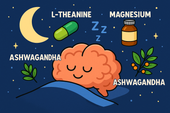
Nootropics That Promote Calm and Rest
Explore the world of calming nootropics — natural brain enhancers that promote relaxation, better focus, and deeper rest. Learn how L-Theanine, magnesium, ashwagandha, and other adaptogens help balance your nervous system, reduce stress, and support restorative sleep.
-

Best Natural Supplement Stack for Sleep
Discover the best natural supplement stack for deep, restorative sleep. Learn how nutrients like magnesium, L-theanine, glycine, and calming herbs such as chamomile and ashwagandha work together to relax your body, calm your mind, and improve sleep quality—naturally and safely.
-

Combining L-Theanine and Magnesium for Sleep: A Calm Night, Naturally
Discover how combining L-Theanine and Magnesium can help you drift into deep, restorative sleep. Learn how this natural duo calms the mind, relaxes the body, and supports your nervous system—without grogginess the next morning.
-

How to Sleep Better After Intense Workouts
Struggling to fall asleep after a tough workout? Learn how to optimize your post-training recovery with nutrition, hydration, and science-backed sleep strategies. Discover how to calm your nervous system, balance hormones, and wake up fully recharged for your next session.
-

Ashwagandha and Valerian: A Bedtime Combo for Deep Rest and Emotional Reset
Discover the calming synergy of Ashwagandha and Valerian root, two natural sleep aids that help quiet the mind, ease anxiety, and promote deeper rest. Learn how this herbal duo supports the nervous system, balances stress hormones, and restores emotional peace — without next-day grogginess.
-

How to Create a Resilience-Boosting Diet
Discover how to build emotional and physical strength from the inside out with a resilience-boosting diet 🍎. Learn which foods stabilize your mood, how supplements like magnesium and omega-3s strengthen your stress response, and why pairing nutrition with breathwork and therapy creates lasting calm, focus, and vitality 🌿💪.
-

Best Teas and Herbal Blends for Calmness: Nature’s Way to Restore Inner Peace
Ashwagandha, the ancient adaptogenic herb, helps your body find balance during stress. Known as “Indian ginseng,” it supports cortisol regulation, boosts energy, and restores calm clarity. Discover how this powerful root promotes resilience, emotional balance, and steady vitality — one cup at a time. 🌸
-

Parenting and Emotional Strength: How to Raise Children Without Losing Yourself
Empathy is the bridge that connects hearts — the quiet power to understand, feel, and support another’s emotions without judgment. Learn how empathy strengthens relationships, enhances communication, and cultivates deeper compassion in everyday life. 🌿
-

How to Bounce Back from Public Failure: Reclaiming Confidence, Purpose, and Power
Visualization is more than imagination — it’s brain training for resilience. By picturing calm, success, or healing, you activate the same neural pathways as real experience. Learn how daily visualization rewires your brain for confidence, emotional balance, and recovery from stress. ✨
-

Coping with Financial Stress Through Resilience: How to Stay Grounded When Money Feels Tight
Body awareness is the foundation of emotional resilience. By tuning into your body’s signals — tension, fatigue, or calm — you learn to recognize stress before it overwhelms you. Discover how mindfulness, gentle movement, and breathwork can deepen your connection with your body and restore balance from the inside out. 🧘
-

How to Stay Positive During Chronic Illness: A Guide to Emotional Strength and Hope
Creativity is more than art — it’s a form of healing. Whether through painting, writing, music, or small acts of expression, creativity helps release emotion, calm the nervous system, and reconnect you to joy. Discover how to use creativity as a tool for emotional balance, resilience, and self-discovery. 🌿
-

Resilience Tips for Caregivers: How to Stay Strong While Caring for Others
Joy isn’t the absence of pain — it’s the quiet strength to find light even in challenging times. Cultivating joy through small daily moments restores balance, releases stress, and reminds you of life’s beauty. Learn how to reconnect with authentic happiness, rebuild emotional energy, and nurture your nervous system through gratitude, presence, and play. 🌿
-

Building Resilience After a Breakup: How to Heal, Rebuild, and Rise Stronger
Social connection is one of the strongest predictors of emotional resilience. During difficult times, genuine relationships act as anchors — calming the nervous system, reducing stress hormones, and helping you regain perspective. Learn how cultivating real human connection can strengthen your mind, heart, and overall well-being. 🌿
-

How to Stay Emotionally Strong During Job Loss
Your emotions are powered by brain chemistry — a delicate balance of neurotransmitters like serotonin, dopamine, and cortisol. When these chemicals work in harmony, you feel calm, focused, and resilient. Learn how daily habits, nutrition, and mindfulness can support your brain chemistry and boost emotional well-being naturally. 🌿
-

The Role of Hormones in Emotional Stability: How Your Chemistry Shapes Your Calm
Hormones shape more than your body — they shape your emotions, resilience, and sense of calm. From cortisol to serotonin, these chemical messengers influence how you react to stress, connect with others, and recover from challenges. Learn how to balance your hormones naturally to build lasting emotional stability and harmony within. 💫
-

Mitochondria and Emotional Energy: The Cellular Power Behind Your Mood
Breathwork is one of the most powerful tools for emotional regulation and cellular balance. Through intentional breathing, you can calm your nervous system, increase oxygen flow to the brain, and even support mitochondrial energy. Learn how conscious breathing connects body and mind — transforming stress into presence and emotional strength. 🌿
-

Inflammation and Its Impact on Mood Resilience: The Silent Link Between Body and Mind
Inflammation doesn’t just affect the body — it impacts the mind. Chronic inflammation alters brain chemistry, depletes serotonin, and makes emotional recovery harder. Learn how calming inflammation through nutrition, mindfulness, and sleep can restore balance, resilience, and a renewed sense of emotional strength. 💫
-
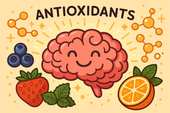
How Antioxidants Protect Emotional Well-being: The Hidden Link Between Oxidative Stress and Mental Health
Antioxidants do more than protect your body — they defend your mind. By neutralizing oxidative stress, antioxidants support serotonin, dopamine, and brain energy pathways that keep you calm, focused, and emotionally balanced. Discover how foods like berries, green tea, and dark chocolate nourish your brain, boost mood, and strengthen resilience from the inside out. 🌿✨
-
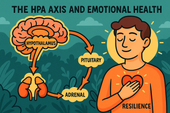
The HPA Axis and Emotional Health: The Hidden Bridge Between Stress and Mind
Neuroplasticity — the brain’s ability to rewire and adapt — is the foundation of emotional healing and resilience. When you face stress, trauma, or change, your neural pathways can reshape themselves to support new patterns of calm, focus, and self-awareness. Learn how daily practices like mindfulness, therapy, and breathwork strengthen neuroplasticity to transform emotional pain into personal growth. 🌸
-
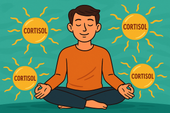
Why Cortisol Control Is Key to Resilience: Mastering Stress to Build Emotional Strength
Controlling cortisol — the body’s main stress hormone — is the secret to lasting resilience. When cortisol levels stay balanced, your mind becomes clearer, emotions steadier, and energy more sustainable. Learn how breathwork, mindset shifts, adaptogens, and daily rhythms can help you calm your stress response and build true inner strength. 🌞💪
-
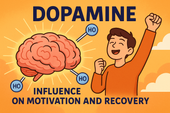
Dopamine’s Influence on Motivation and Recovery: Reigniting Drive and Balance
Healthy relationships are the foundation of emotional balance and resilience. Whether romantic, familial, or platonic, genuine connection releases dopamine, serotonin, and oxytocin — the brain’s “bonding trio” — helping us feel secure, motivated, and seen. Learn how trust, empathy, and communication not only strengthen your connections but also reshape your nervous system for deeper emotional well-being. 🌿🤝
-
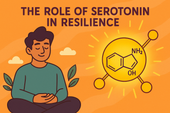
The Role of Serotonin in Resilience: How This “Mood Molecule” Shapes Emotional Strength
Serotonin — often called the “resilience molecule” — plays a vital role in how we handle stress, regulate mood, and recover from emotional challenges. Beyond happiness, this powerful neurotransmitter helps balance the gut-brain axis, stabilize the nervous system, and support emotional flexibility. Learn how nutrition, sunlight, mindfulness, and adaptogens can naturally boost serotonin and strengthen your emotional resilience. 🌞🧠
-

Tai Chi and Adaptogens for Mind-Body Balance: The Art of Harmonizing Energy and Resilience
Alchemy isn’t just an ancient science — it’s a timeless symbol of transformation and inner balance. By blending the physical and spiritual, alchemy teaches us that change begins from within. Just as metals are refined into gold, we too can transmute emotional pain, stress, and chaos into clarity and strength through mindful practice and self-awareness. 🌙✨
-

Cold Therapy and Emotional Control: Training the Mind Through the Body
Cold therapy isn’t just for athletes — it’s a tool for emotional mastery. By exposing your body to controlled cold, you train your nervous system to stay calm under stress, improving focus, mood, and resilience. This article explores the science of cold exposure, its impact on hormones and the vagus nerve, and how ice baths and cold showers can help you build emotional control, one breath at a time. 🧊🧘♂️
-

How Music Influences Emotional Recovery: The Healing Soundtrack of the Mind
Neuroplasticity — the brain’s ability to rewire and heal itself — is at the heart of emotional recovery. Through mindful habits, music, therapy, and consistent mental stimulation, your brain can form new connections that support resilience and well-being. Discover how neuroplasticity turns pain into growth, helping you rebuild balance, focus, and emotional strength. 🌿
-

Nature Therapy for Building Resilience: Reconnecting With the Healing Power of the Earth
Nature therapy helps rebuild emotional resilience by reconnecting you with the healing rhythms of the Earth. From forest walks to sunlight exposure, nature restores balance to your nervous system, lowers stress hormones, and teaches emotional adaptability. Learn how spending time outdoors can enhance mental clarity, calm anxiety, and awaken your natural capacity to heal. 🌞
-

Breathwork Techniques That Pair with Supplements: The Ultimate Synergy for Stress Relief and Mental Clarity
Breathwork and supplements create a powerful mind-body synergy for stress relief, focus, and energy. By combining intentional breathing with adaptogens, nootropics, and calming nutrients, you can naturally regulate cortisol, sharpen mental clarity, and boost emotional balance. This guide explores the best breathwork techniques and supplement pairings to help you feel centered, calm, and energized from the inside out. 🌿
-
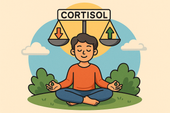
Why Cortisol Balance Matters for Emotional Strength
Balancing cortisol — your body’s main stress hormone — is essential for emotional resilience. When cortisol is chronically high, your mind stays stuck in survival mode, leading to fatigue, anxiety, and emotional instability. This article explores how nutrition, supplements, breathwork, and therapy can help restore healthy cortisol rhythms, regulate the nervous system, and strengthen your ability to handle life’s challenges with calm focus and emotional strength. 🌿
-

Best Supplements for Students During Exam Season: Focus, Energy, and Memory Support
Studying late into the night? Learn which natural supplements can boost focus, memory, and mental stamina during exam season — without the crash. From omega-3s to Bacopa and Rhodiola, discover your brain’s ultimate exam support stack. 🎓🧠
-
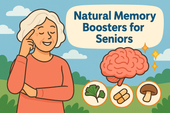
Natural Memory Boosters for Seniors: How to Keep Your Mind Sharp and Focused
Stay mentally sharp and confident as you age. Discover science-backed natural supplements and lifestyle habits that boost memory, focus, and brain longevity for seniors. 🌿🧠
-
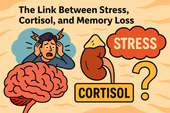
The Link Between Stress, Cortisol, and Memory Loss
Chronic stress can quietly erode your memory — and cortisol is the key culprit. Learn how stress hormones affect the brain, why the hippocampus shrinks under pressure, and how natural strategies can help you restore memory and mental clarity. 🧠✨
-

How to Build a Daily Supplement Routine for Memory Health
Want to sharpen your memory and stay mentally clear? Learn how to build a daily supplement routine for memory health — from morning focus to nighttime brain repair. Discover science-backed nutrients that boost recall, focus, and long-term cognitive resilience. 🧠🌿
-
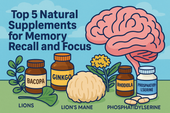
Top 5 Natural Supplements for Memory Recall and Focus
Looking to boost memory and concentration naturally? Discover the top 5 supplements — Bacopa, Ginkgo Biloba, Lion’s Mane, Rhodiola, and Phosphatidylserine — that enhance focus, recall, and long-term brain health. 🧠✨
-

Top Supplements to Balance Mood Naturally
From omega-3s to adaptogens, discover the top natural supplements proven to support emotional balance, reduce stress, and promote inner calm — safely and effectively. 🌿✨
-
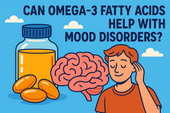
Can Omega-3 Fatty Acids Help with Mood Disorders?
Omega-3 fatty acids do more than support heart health — they can help balance mood, reduce depression, and calm anxiety. Discover how EPA and DHA nourish your brain, fight inflammation, and support emotional well-being from within. 🌊🧠
-

Vitamin D and Mood: The Sunshine Vitamin for Emotional Balance
Could the key to emotional balance be as simple as a little sunlight? Discover how vitamin D — the sunshine vitamin — influences serotonin, reduces inflammation, and helps you feel more positive and resilient year-round. ☀️💛
-

The Role of Magnesium in Reducing Irritability and Low Mood
Feeling on edge or emotionally drained? Magnesium could be the missing link between your body and your mood. Discover how this essential mineral reduces irritability, balances neurotransmitters, and helps your nervous system find calm again. 🌿✨
-
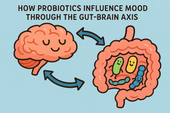
How Probiotics Influence Mood Through the Gut-Brain Axis
Discover how probiotics can do more than support your digestion—they can actually uplift your mood. This article explores the fascinating gut-brain axis and how balancing your gut bacteria through probiotics may help reduce anxiety, improve emotional stability, and support long-term mental well-being. 🌿🧠
-

Ashwagandha for Stress and Mood Regulation
Discover how Ashwagandha, the powerful adaptogenic herb 🌿, helps your body manage stress and regulate mood. Learn how it balances cortisol, boosts GABA and serotonin, and supports emotional stability — helping you feel calm, focused, and resilient every day.
-

St. John’s Wort: Natural Support for Mild to Moderate Depression
Discover how St. John’s Wort, the “sunshine herb” 🌼, naturally supports mild to moderate depression. Learn how it boosts serotonin, balances mood, and promotes emotional resilience — with research showing its effectiveness compares to antidepressants, but with fewer side effects.
-
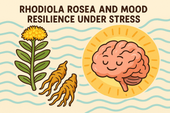
Rhodiola Rosea and Mood Resilience Under Stress
Discover how Rhodiola rosea helps your body adapt to stress 🌿. Learn how this powerful adaptogen balances cortisol, supports serotonin and dopamine, and strengthens emotional resilience — helping you stay calm, focused, and energized under pressure.
-

Chamomile and Lavender: Herbal Calm for Emotional Fluctuations
Discover how chamomile and lavender bring calm to emotional ups and downs 🌿. Learn how these two soothing herbs balance your nervous system, ease anxiety, and support restful sleep — naturally helping you find peace and emotional stability.
-
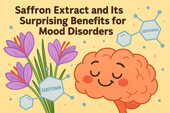
Saffron Extract and Its Surprising Benefits for Mood Disorders
Discover how saffron extract — the golden spice of joy 🌸 — can naturally support mood balance, ease anxiety, and lift mild depression. Learn what science says about its serotonin-boosting power, the ideal dosage, and how this ancient remedy compares to modern antidepressants.
-
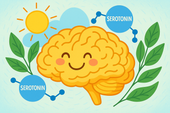
5-HTP and Serotonin: A Natural Path to Lifting Mood
Discover how 5-HTP naturally boosts serotonin 🌞 — the neurotransmitter behind mood, sleep, and emotional balance. Learn how this plant-derived compound supports happiness, reduces anxiety, and improves rest by helping your brain create more serotonin the gentle, natural way.
-
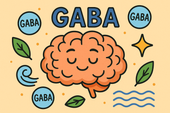
GABA Supplements for Reducing Anxiety and Mood Swings
Discover how GABA supplements can help reduce anxiety and balance mood naturally 🌿. Learn how this calming neurotransmitter works to quiet the mind, ease stress, and improve sleep — plus which nutrients and habits can boost your body’s own GABA production for long-term emotional stability.
-
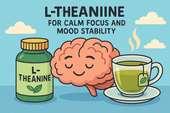
L-Theanine for Calm Focus and Mood Stability
Discover how L-theanine, the calming compound found in green tea 🍵, promotes focus, relaxation, and mood stability. Learn the science behind how it balances neurotransmitters, reduces stress hormones, and enhances clarity — helping you stay centered, calm, and productive without sedation.
-
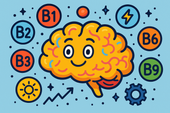
B Vitamins and Brain Chemistry: Supporting Energy and Emotional Balance
Discover how B vitamins power your brain chemistry ⚡. Learn how B6, B9, and B12 support serotonin, dopamine, and energy production — helping boost focus, mood, and emotional balance. From diet to supplements, explore how this vital nutrient group keeps your mind resilient and your energy steady.
-

N-Acetyl Cysteine (NAC) and Mood Disorders: What the Research Says
Learn how N-Acetyl Cysteine (NAC) supports brain health and mood balance 🧠. Discover how this antioxidant helps reduce oxidative stress, regulate glutamate, and improve emotional stability in depression, bipolar disorder, and anxiety — backed by cutting-edge psychiatric research.
-

Supplements for Bipolar Disorder: What May Support Stability
Discover the best supplements for bipolar disorder 🌿 that may support emotional stability and brain health. Learn how nutrients like omega-3s, magnesium, vitamin D, and NAC can help reduce inflammation, balance neurotransmitters, and complement traditional treatment safely.

















































